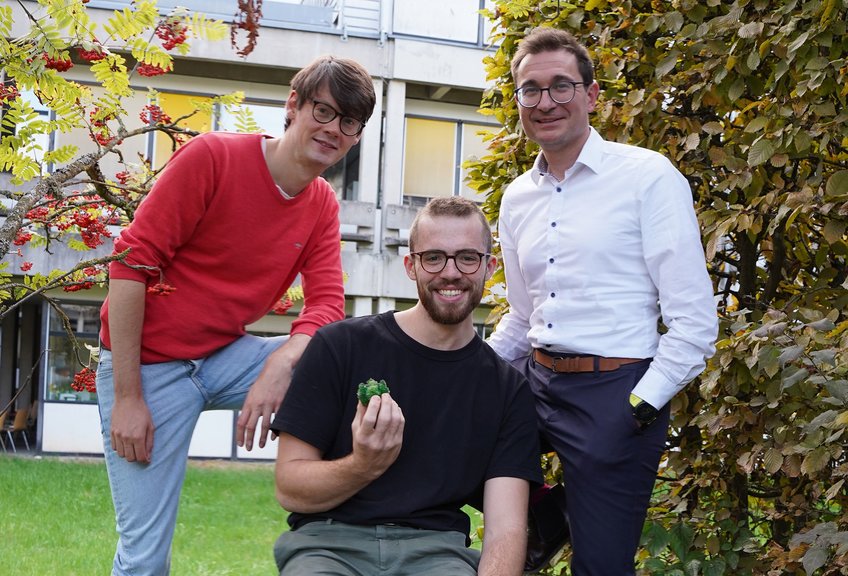In our interview, lead scientist Tobias Erb explains why knowing the history of proteins might help create alternatives for the future

Tobias Erb (right) with Luca Schulz, first author of the study.
© MPI for Terrestrial Microbiology
In order to understand how photosynthesis adapted to the presence of oxygen billions of years ago, you resurrected long-extinct enzymes in the lab. What was the starting point for this research?
Tobias Erb: Studying the mechanisms that allow enzymes to capture and convert CO2 is at the heart of research in our lab. But how did these powerful CO2-converting catalysts emerge and adapt to dramatic changes in the environment over billions of years? In paleontology we can make use of fossilized bones to understand the evolution of species, like us humans. However, there is no “molecular fossils” of proteins that we could use to learn about their evolution. Meeting Georg [Hochberg], who is an expert in reconstructing the history of proteins over billions of years opened the exciting possibility to finally go back in time to reconstruct ancient Rubisco versions. Through this molecular time travel, we can now retrace the key steps in the history of Rubisco and understand how this enzyme became the dominant CO2 capturing machine on earth that converts more than 1.25 billion tons of CO2 per day.
The proteins you are studying have long since disappeared on earth. Why is this relevant for us humans today?
Well, every bite of food that you take, every carbon atom that you eat is basically CO2 that was fixed through Rubisco. This enzyme literally feeds all life on this planet. I believe that there is some value in understanding how this essential process on earth evolved. One lesson is that evolution apparently tends to build more complex machines with time. Understanding the molecular principles behind this process tells us about the potential, but also the limitations of evolution as an optimization force. There is another angle to the story: we can try to use this knowledge to replay evolution and guide it into another direction. So unlike the famous quote of Robert Penn Warren who said: “History cannot give us a program for the future”, there is at least some tools we can use to create an alternative future starting from these ancient proteins.
How do you resurrect an ancient protein?
The last step of this process is to recreate these ancient proteins in the lab. This ‘resurrection’ of ancient proteins technically very simple and uses synthetic biology techniques that are very much routine by now: you produce the ancient protein according to a genetic “blueprint” in bacteria. It is almost like 3D printing an ancient object with a biological “printer”. Once you have that, you can purify this protein and measure its various biochemical properties.
How could we theoretically use this knowledge to boost photosynthesis?
We know that plants suffer from the very slow CO2 conversion speed of Rubisco and the enzyme’s poor discrimination against O2. This makes Rubisco a prime target for any efforts to improve photosynthesis and crop yield. So far, scientists mainly focused on modifying Rubisco itself by changing the enzyme’s core to improve its catalysis. However, this has only met with limited success. The surprising discovery of our study is that you can improve Rubisco by simply adding additional protein components that ‘activate’ otherwise silent mutations in the protein. This “evolutionary modulation” of Rubisco through the small subunit gives a completely different perspective on future engineering efforts. Imagine that we do not have to modify the core of the enzyme itself, but screen for new modulators that allow us to unleash the full catalytic power that is already present, but hidden in the enzyme’s core. This is a completely novel road that no one has taken so far.
Why is this research important in the context of climate change?
Our research has two important aspects. First it explains, how Rubisco, the biocatalyst that captures 95% of the CO2 on earth, 400 billion tons CO2 per year, has evolved and adopted towards environmental changes over the billions of years of evolution. One dramatic challenge was the rise of oxygen on ancient earth, which has put enormous pressure on the enzyme. We now know, that from the beginning the enzyme was prepared to deal with oxygen because it had already recruiting its new interaction partner even before there was any oxygen around. Knowing these principles at work, we can try to make predictions about future scenarios and answer the question whether we can overcome the current limitations of Rubisco. Remember, that the enzyme is (still) surprisingly slow and can tolerate, but not fully discriminate against oxygen. And this brings me also to the second aspect of our research, which is more applied. We can now think about replaying the tape of evolution with our ancestral proteins provide it with completely novel interaction partners to improve the enzyme’s catalysis and eventually overcome the natural limitations.






